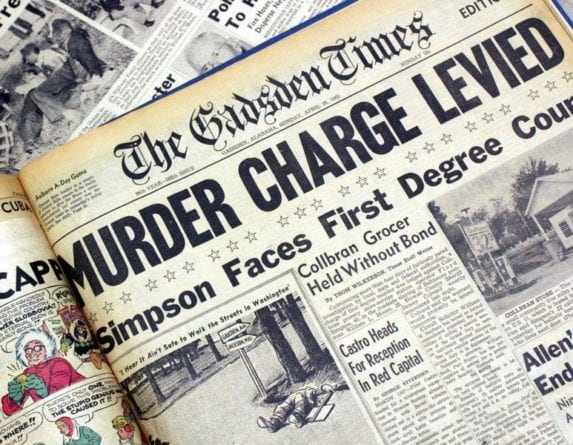The struggle for civil rights in the United States has a murderous history. Unfortunately, because of lingering institutional racism in the south, a lot of these murders were not fully investigated and a number of them still remain unsolved today. One such case is that of William Lewis Moore, a staunch advocate for civil rights. He was raised in Mississippi but on the white side of town.
Moore was born in Binghamton, New York, but following the death of his mother, 2-year-old Moore moved to live with his grandparents in Russell, Mississippi. As an adult, Moore served as a combat Marine in the Pacific Theater before having a mental breakdown in the mid-1950s. Moore was institutionalised for three and a half years and was diagnosed with schizophrenia. Following his release, he became a staunch and dedicated activist for the mentally ill. He wrote a book titled “Mind in Chains” in which he described his experiences in a psychiatric hospital and started a newsletter about the stigma associated with being mentally ill.1

He soon became involved with the civil rights movement and subsequently fought for the rights of African Americans. Moore would often organise demonstrations for civil rights in Binghampton and became a member of the Congress of Racial Equality (CORE) which was a vital arm of activism at the time. Moore moved to an apartment in the 400 block of E. 25th St in Baltimore so that he could be closer to civil rights organisations. In 1963, he was arrested while at a segregation protest in the Northwood Theatre.
In Baltimore, Moore made individual walks emphasising rights for African Americans to the state capitol in Annapolis, Maryland, and even to the White House where he was refused admission and his hand-written letter to President John F. Kennedy was denied.2 Moore’s letter said that he wanted to walk to Mississippi to confront segregationist Mississippi Gov. Ross Barnett and that if the president wanted anything delivered, he would happily take it with him. Growing up in Mississippi, Moore had been horrified to witness Gov. Ross Barnett giving pro segregation speeches as Confederate flags fluttered behind him in the wind.
Despite the knock-back at the White House, Moore applied for a two week vacation from his job at the post office, and continued planning his walk to Mississippi where he wanted to hand deliver a letter to Gov. Ross Barnett, urging him to fundamentally change Mississippi’s racial hierarchy. In this letter, Moore warned “do not go down in infamy as one who fought the democracy for all which you have not the power to prevent.”
Everybody begged Moore not to go and warned him that protesting segregation in the deep South was a death wish. Despite their worries, Moore was adamant that he was going to make a change. “He told me he hoped to awaken the whole world, not only the South, to its racial obligations. He said if the day would ever come when the Negro race gained authority that the Negroes would be kinder to the white races than the whites had been to the Negroes,” said Herbert Gardner, a colleague of Moore, in an interview with The Evening Sun. Moore purchased a bus ticket to Chattanooga, Tennessee, which is where he wanted to begin his walk to Jackson, Mississippi – a lengthy trek of almost 400 miles. He planned on walking 40 miles for 10 days. Tragically, Moore never got a chance to deliver the letter; he would be shot dead while walking to his destination.
It was the 21st of April, 1963, when Moore set off on his trek. He was wearing a sandwich board which proudly read:

“Equal rights for all & Mississippi or Bust” and on the other side: “End Segregation in America” and “Eat at Joe’s – Black and White.” In addition, he pulled a two-wheeled postal cart which contained a photograph of Jesus along with the text: “Wanted: Agitator, Carpenter by Trade, Revolutionary, Consorter with Criminals and Prostitutes.” Along his way, Moore certainly attracted some stares and confrontations, all of which he documented in his journal. According to Mary Stanton, author of Freedom Walk, the polite individuals interrogated him about his intentions and urged him to turn back; the others, however, threatened him. And around 70 miles into his journey, Moore was met by somebody who did much more than just threaten him.
Dusk was fast approaching on the 23rd of April. 1963; Ellis Elrod was driving along a lonely two-lane stretch of U.S. Highway 11 in rural north eastern Alabama when he spotted a glimpse of something at the side of the road. Elrod decided to turn his car around to get a better look at what he had seen. As his flashlights illuminated the area, he was met by a grisly scene. Lying at the side of the road, just underneath a walnut tree, was the body of Moore. Alongside his bloody, lifeless, body was the two signs he had been proudly carrying just hours earlier. An autopsy concluded that Moore had been killed by two bullets; one entered above his left eyebrow and the other entered his throat. It was determined that the fatal shots had come from a .22-caliber automatic rifle.
The murder sent shock-waves through the civil rights movement; the white supporters saw a Northern white man consumed by the violence that was mostly perpetrated against African Americans. African Americans saw just how far segregationists would go. “He was white and he was killed. That in itself triggered a lot of things in both the black and white community,” said Robert Avery, a Gadsden City Council member. Several weeks later, ten members of CORE and the Student Nonviolent Coordinating Committee attempted to complete Moore’s walk, leaving from Chattanooga. According to several eyewitness reports, they were taunted unmercifully. “Hope you stop a .22” mocked one passer-by. When the group arrived in Alabama, they were arrested and jailed. They were subsequently transferred to Kilby State Prison in Montgomery and, according to one source, were housed on Death Row. They were released a month later.
Floyd Simpson, a Ku Klux Klan member, was picked up on suspicion of the murder after a witness had seen a car like his near the crime scene. Following his arrest, the state compared shells taken from the murder scene and bullets from Moore’s body to rounds that were fired from Simpson’s rifle. The examination indicated that the shell markings were identical to those on the test casings. As it was soon discovered, Simpson and Moore had an unsavoury meeting just hours before Moore was shot dead. Simpson owned a shop in Alabama and as he saw Moore stroll past, he called him over. “They didn’t think I’d finish my walk alive. They didn’t think people believed I really stood for the things I did,” wrote Moore in his journal. Moore also wrote how he felt threatened by Simpson. Later on in the same day, he wrote “A couple of men who had talked to me before drove up and questioned my religious and political beliefs,” he wrote. “’Now I know what you are,’ one of the men said. And one was sure I’d be killed for them, such as my ‘Jesus’ poster on my buggy.”
Nevertheless, on the 13th of September. 1963, a grand jury declined to indict Simpson.
The years passed and witnesses and investigators died. Somehow, somewhere along the way, the bullets and other evidence went missing. In 1989, The Civil Rights Memorial was unveiled in Montgomery, Alabama. The Southern Poverty Law Center built the memorial “to commemorate the achievements of the civil rights era and to honor those who died during that struggle.”3 Forty people are memorialised on the monument, one of which is William Lewis Moore. In 2009, the FBI reopened the case but closed it again, stating there were no new leads.
Through time, Moore’s death has been overshadowed by more symbolic moments in civil rights history. Although his plight isn’t as well known, it is an important chapter in the historic civil rights movement. While Moore never got the chance to deliver his letter, he is remembered today for his bravery. He became a rallying cry for a movement that saw passage of the landmark Civil Rights Acts just the following year. Today, the message in his letter can be heard loud and clear across the world.







Comments:
What a compassionate man. He knew it was a death trap but still did what he thought was right. A true hero…
He really is a true hero. Even today racism is still alive and well in the USA. This needs to be taught in school.
couldnt agree mmore. such a smart man
While we may not know or acknowledge, his sacrifice and activism duly inspired true, lasting change. It’s a struggle!
Rest in Peace, kind soul
Ironically, Moore, a former Marine, had fought in World War ll, taking part in the American invasion of Guam in 1944 and survived that bloody battle against the fanatic Imperial Japanese army. Only to be murdered in the same country he fought to defend and defending other Americans, including Black ones. Cheers to you, Mr. Moore and Mrs. Moore.
This was my favorite story in the sense that he has such a beautiful soul. He just wanted to make the world a better place and instead the world wasn’t ready for him to change it yet u fortunately. However I will remember as much as I can for his sacrifice. What a what sweet sweet beautiful man he saw that the world could and should be. I hope he’s resting easy and I thank him so much. I’ve spent about 12 hours reading your stories and this one touched me the south being and living in the Deep South.… Read more »